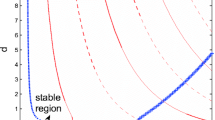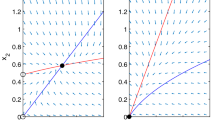Abstract
In this paper we formulate a multi-patch multi-species model in which the percapita emigration rate of one species depends on the density of some other species. We then focus on Turing instability to examine if and when this cross-emigration response has crucial effects. We find that the type of interaction matters greatly. In the case of competition a cross-emigration response promotes pattern formation by exercising a destabilizing influence; in particular, it may lead to diffusive instability provided that the response is sufficiently strong, which contrasts sharply with the well-known fact that the standard competition system does not exhibit Turing instability. In the case of prey-predator or activator-inhibitor interaction it acts against pattern formation by exerting a stabilizing effect; in particular, the diffusive instability, even though it may happen in a standard system, never occurs when the response is sufficiently strong. We conclude that the cross-emigration response is an important factor that should not be ignored when pattern formation is the issue.
Similar content being viewed by others
References
Allen, J. C. (1975). Mathematical models of species interactions in time and space. Am. Nat. 109, 319–342.
Almirantis, Y. and S. Papageorgiou (1991). Cross-diffusion effects on chemical and biological pattern formation. J. Theor. Biol. 151, 289–311.
Amann, H. (1990). Dynamics of quasilinear parabolic equations II. Reaction-Diffusion Syst., Differ. Integral Equations 3, 13–75.
Amann, H. (1993). Nonhomogeneous linear and quasilinear elliptic and parabolic boundary value problems, in Function Spaces, Differential Operators and Nonlinear Analysis, Teubnertexte Math. 133, H. Schmeisser and H. Triebel (Eds), Teubner: Stuttgart and Leipzig, pp. 9–126.
Amann, H. (1995). Linear and Quasilinear Parabolic Problems, Vol. 1, Abstract Linear Theory, Basel, Boston, Berlin: Birkhauser Verlag.
Aronson, D. G. (1985). The role of diffusion in mathematical population biology: skellam revisited, in Mathematics in Biology and Medicine, Lecture Notes in Biomathematics 57, V. Capasso (Ed.), pp. 2–6.
Bernstein, C. (1984). Prey and predator emigration responses in the acarine system Tetranychus urticae-Phytoseiulus persimilis. Oecologia 61, 134–142.
Capasso, V. and A. Di Liddo (1994). Asymptotic behaviour of reaction-diffusion systems in population and epidemic models-the role of cross-diffusion. J. Math. Biol. 32, 453–463.
Chattopadhyay, J. and P. K. Tapaswi (1993). Order and disorder in biological systems through negative cross-diffusion of mitotic inhibitor—a mathematical model. Math. Comput. Modelling 17, 105–112.
Chattopadhyay, J. and P. K. Tapaswi (1997). Effect of cross-diffusion on pattern formation—a nonlinear analysis. Math. Comput. Modelling 48, 1–12.
Crowley, P. H. (1981). Dispersal and stability of predator-prey interactions. Am. Nat. 118, 673–701.
Durrett, R. and S. Levin (1994). The importance of being discrete (and spatial). Theor. Pop. Biol. 46, 363–394.
Edelstein-Keshet, L. (1987). Mathematical Models in Biology, Birkhauser Mathematics Series, New York: McGraw-Hill Inc.
Farkas, M. (1997). Two ways of modeling cross diffusion. Nonlinear Anal. TMA 30, 1225–1233.
Grindrod, P. (1996). The Theory and Applications of Reaction-Diffusion Equations, Oxford: Clarendon Press.
Hastings, A. (1990). Spatial heterogeneity and ecological models. Ecology 71, 426–428.
Holmes, E. E., M. A. Lewis, J. E. Banks and R. R. Veit (1994). Partial differential equations in ecology: spatial interactions and population dynamics. Ecology 75, 17–29.
Huang, Y. and O. Diekmann (2001). Predator migration in response to prey density: what are the consequences? J. Math. Biol. 43, 561–581.
Jansen, V. A. A. and A. L. Lloyd (2000). Local stability analysis of spatially homogeneous solutions of multi-patch systems. J. Math. Biol. 41, 232–252.
Jorńe, J. (1974). The effect of ionic migration on oscillations and pattern formation in chemical systems. J. Theor. Biol. 43, 375–380.
Lou, Y. and W.-M. Ni (1996). Diffusion, self-diffusion and cross-diffusion. J. Differ. Equations 131, 79–131.
Marcus, M. and H. Minc (1964). A Survey of Matrix Theory and Matrix Inequalities, Boston: Allyn and Bacon Inc.
Murray, J. D. (1993). Mathematical Biology, Berlin, Heidelberg, New York: Spinger.
Ni, W.-M. (1998). Diffusion, cross-diffusion and their spike-layer steady states. Notices AMS 45, 9–18.
Okubo, A. (1980). Diffusion and Ecological Problems: Mathematical Models, Berlin: Springer.
Okubo, A. and S. Levin (2000). Diffusion and Ecological Problems: Modern Perspectives, 2nd edn, Berlin: Spinger.
Othmer, H. G. and L. E. Scriven (1971). Instability and dynamic patterns in cellular networks. J. Theor. Biol. 32, 507–537.
Pels, B. (2001). Evolutionary dynamics of dispersal in predatory mites, PhD thesis, Amsterdam University.
Plahte, E. (2001). Pattern formation in discrete cell lattices. J. Math. Biol. 43, 411–445.
Sabelis, M. W. (1981). Biological control of two-spotted spider mites using phytoseid predators. Part I: Modelling the Predator-prey Interactions at the Individual Level. Wageningen: Agric Res Rep Centre for Agricultural Publication and Documentation.
Segel, L. A. (1984). Taxes in cellular ecology, in Mathematical Ecology, Lecture Notes in Biomathematics 54, S. A. Levin (Ed.), pp. 407–424.
Segel, L. A. and J. L. Jackson (1972). Dissipative structure: an explanation and an ecological example. J. Theor. Biol. 35, 545–559.
Shigesada, N., K. Kawasaki and E. Teramota (1979). Spatial segregation of interacting species. J. Theor. Biol. 79, 83–99.
Takafuji, A. (1977). The effect of successful dispersal of a phytoseiid mite Phytoseiulus persimilis. Athias-Henriot (Acarina: phytoseiidae) on the persistence in the interactive system between the predator and its prey. Res. Popul. Ecol. 18, 210–222.
Turing, A. (1952). The chemical basis of morphogenesis. Phil. Trans. R. Soc. B 237, 37–72.
Author information
Authors and Affiliations
Corresponding author
Rights and permissions
About this article
Cite this article
Huang, Y., Diekmann, O. Interspecific influence on mobility and Turing instability. Bull. Math. Biol. 65, 143–156 (2003). https://doi.org/10.1006/bulm.2002.0328
Received:
Accepted:
Issue Date:
DOI: https://doi.org/10.1006/bulm.2002.0328




